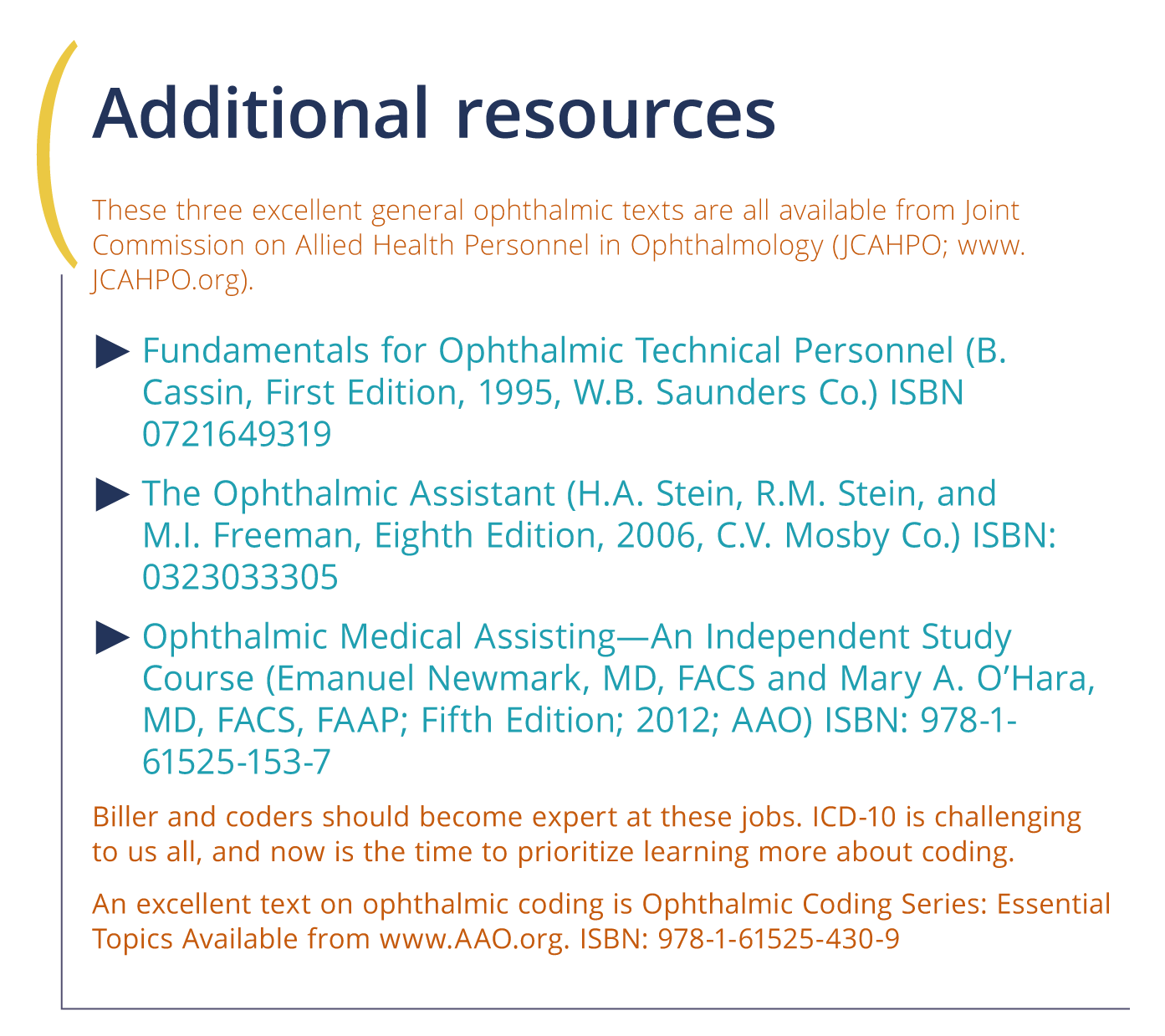10 steps to a phenomenal patient experience
Taking these 10 steps will help lead your patients to receiving a phenomenal experience and take your technician career to the next level.



Every business provides a product or a service. Products are consumed; services are experienced. Technicians in eyecare practitioner offices provide patients with an experience. Whether the patient you just helped returns to your practice again or refers others to your practice depends on the quality of his experience.
Why should it matter to you whether your patients have a good experience? The reality is patients have a choice of where to go for their medical care. If your patient doesn’t have a great experience-or worse yet has a bad experience-he won’t be your patient for very long.
Your job security is directly related to the success of your practice, which means the quality of experience you provide the patient is directly related to your job security.
Practices must continually drive new patients in the door in order to maintain a constant patient load. Marketing, professional referrals, and good word of mouth brings them in the door. After that, it’s up to you whether they stay or they don’t.
Providing a positive and memorable experience for your patient is the key to long-term success in your career. “Success in your career” does not simply refer to financial rewards or promotions. While these are all important, they are not what I would consider to be true success.
True career success comes from the deep satisfaction you’ll have when you bring your personal best to everything you do-including your customer service skills. When you practice the 10 steps outlined in this article, you’ll take your job to a whole other level-one that allows you to provide a phenomenal patient experience.
1. Know who is the boss
Who do you work for? If you think you work for your doctor or your clinic, think again. Your employer handles money and manages practice resources; however, you work for the patient. The patient is your boss and the very reason you are there.
We have all heard the saying, “You never get a second chance to create a first impression.” That opportunity comes when a new patient calls the office or walks through the office door. Look into incorporating simple, yet powerful strategies to wow new patients and leave a positive, lasting impression they will share with their family and friends.
2. Manage difficult situations and patients with finesse
We have all dealt with patients who are difficult-the patient with 10 pairs of glasses or the patient who is difficult to fit into the slit lamp. Those who work with the public must know how to interact with a wide variety of people in a positive manner. Employers consistently say they value staff who demonstrate good interpersonal skills.
It’s important to realize the patient doesn’t intend to be annoying or a problem. You are not there to win, and it’s not your job to have an opinion about the patient. The patient is there for a service.
Overlook annoyances and don’t take personally things the patient says or does no matter how they come across to you. Focus on problem solving. Be empathetic (sensitive, compassionate) and sympathetic (understanding), and get the job done.
3. Stay ultra aware of time
Excessive waits are one of the most frequent complaints about doctors’ offices. While we cannot always prevent excessive waits, it is every team member’s responsibility to do their part to limit the amount of wait time the patient experiences.
Most patients will tolerate a 15-minute wait without complaint, but once the 15-minute mark is crossed, most people begin to get antsy and wonder how much longer the wait will be. After 30 minutes have passed, many patients will begin getting irritated and might even wonder if they have been forgotten.
This is why early intervention is important.
Avoid a clock in the waiting area. Watching the clock continually will make the time seem to go by much more slowly than it actually does.
Let patients know approximately how much longer their wait will be. When a patient will be the next to be seen, let him know. This will “reset the clock” in his head. The wait will seem shorter, and he will tolerate it better than if he is not given an update while he waits.
Front desk personnel must constantly be aware of patients’ wait time. If a patient waits more than 15 minutes past his appointment time, get an idea of how much longer the wait will be and let the patient know. Again, this will “reset the clock.”
4. Keep up to date
Have you ever been a patron in a place of business in which it was clear to you that the staff wasn’t knowledgeable about the products or services they offered? Did you feel confident in this place of business, or did it make you want to go a competitor?
Patients trust staff members who are knowledgeable and passionate about what they do. We owe it to our patients to bring our very best to every patient encounter. Doing so will increase your patients’ satisfaction with your practice.
The key to becoming more knowledgeable is to read. Read everything you can get your hands on about eye care. Every person in the practice, including front office staff, must have a thorough knowledge of ophthalmic anatomy, physiology, terminology, and basic eye diseases. See “Additional resources” box for more.
5. Use amazing phone skills
I’m always impressed when I call a place of business, and the person who answers the phone sounds as if my call has been the only call she has answered all day.
Many physicians’ practices get 100 or more calls a day. When you answer the phone, listen to the tone and pace of your greeting. Ask yourself if it sounds like you’re answering the phone for the hundredth time that day or if it sounds like it is the first time.
6. Give patients more than they expect
Most patients chose their physicians by asking people they trust for a recommendation. Today’s consumer is increasingly savvy and has more resources for making this decision than ever before.
More and more patients are utilizing online physician reviews as a part of this decision-making process. The consumer has embraced the notion that knowledge is power.
A 2013 study found that a half-star increase in physician rating leads to a 10 percent increase in likelihood that the physician will fill an appointment.1 This study states, “Consumers face uncertainty regarding the quality of the treatment received and may rely on imperfect signals to infer quality.”
It’s more important than ever that we manage our patients’ encounters so they are left with a positive impression.
Most of us have expectations when we engage with a business. I hope that your practice has a stellar reputation in your community, and as such your patients have come to expect equally stellar service. Give patients more than they expect.
7. Imagine you’re on stage
Have you ever been to Walt Disney Word or Disneyland? If you have, then you know that Disney is expert at creating an experience for its guests. Disney immerses the guest in the culture of Disney movies and characters.
Disney refers to its employees as “cast members.” Disney cast members are expected to be “on stage” whenever a guest can see or hear them. When they are on stage, the “show is on.” This helps create the best possible customer experience.
Technicians are “on stage” whenever a patient can see or hear us. When we are “on stage,” our conversations and actions should be professional and patient-centered.
8. Listen to and learn from patient feedback
Patient satisfaction surveys are an inexpensive and effective way to find out what you’re doing right (so you can do more of it) and what you’re doing wrong (so you can fix it).
Ask yourself what information you hope to learn from the survey. Your answer will guide the survey questions you ask.
The ideal survey will be brief-just a few questions (keep it under 10 questions) with easy check boxes and a blank line at the end for comments.
9. Work as a team
A chain is only as strong as its weakest link. Each staff member is a link in the chain that is the team.
An effective team should demonstrate these values and habits:
• Leave your ego at the door. Being a member of a team requires that each person work toward common goals-not for personal glory.
• Celebrate successes as a team. If every goal is a common goal, then reaching that goal should be a shared celebration.
• Don’t play the blame game. Look for solutions, not a scapegoat.
• Respect one another. Never criticize or belittle the ideas or contributions of a teammate.
• Give your all-all the time. Contribute ideas and offer help to your co-workers-especially without being asked. Assist your fellow workers every day toward the common goal.
• Show genuine concern for your coworkers.
• Learn to enjoy the company of your teammates even if they aren’t people you would normally befriend. Practice tolerance of people who are different from you.
10. Use positive language
Positive language can be powerful and strategic in handling interactions with others. Negative language can be destructive. Delivery is critical because it sets the tone for the interaction.
Compare these two statements:
“I can't get you that frame until next month; it is back-ordered and unavailable at this time.”
“That frame will be available next month. I can place the order for you right now and make sure that it is sent to you as soon as it’s available.”
Think these positive words as you say them. Positive language works only when it sounds natural and genuine. Smile, speak normally and don’t over emphasize your language or you will sound forced and scripted.
Taking these 10 steps will help lead your patients to receiving a phenomenal experience and take your technician career to the next level.
References:
1.Luca M, Vats S. Digitizing Doctor Demand: The Impact of Online Reviews on Doctor
Choice. Available at: https://www.aeaweb.org/conference/2014/retrieve.php?pdfid=55. Accessed 5/23/18.
Newsletter
Want more insights like this? Subscribe to Optometry Times and get clinical pearls and practice tips delivered straight to your inbox.